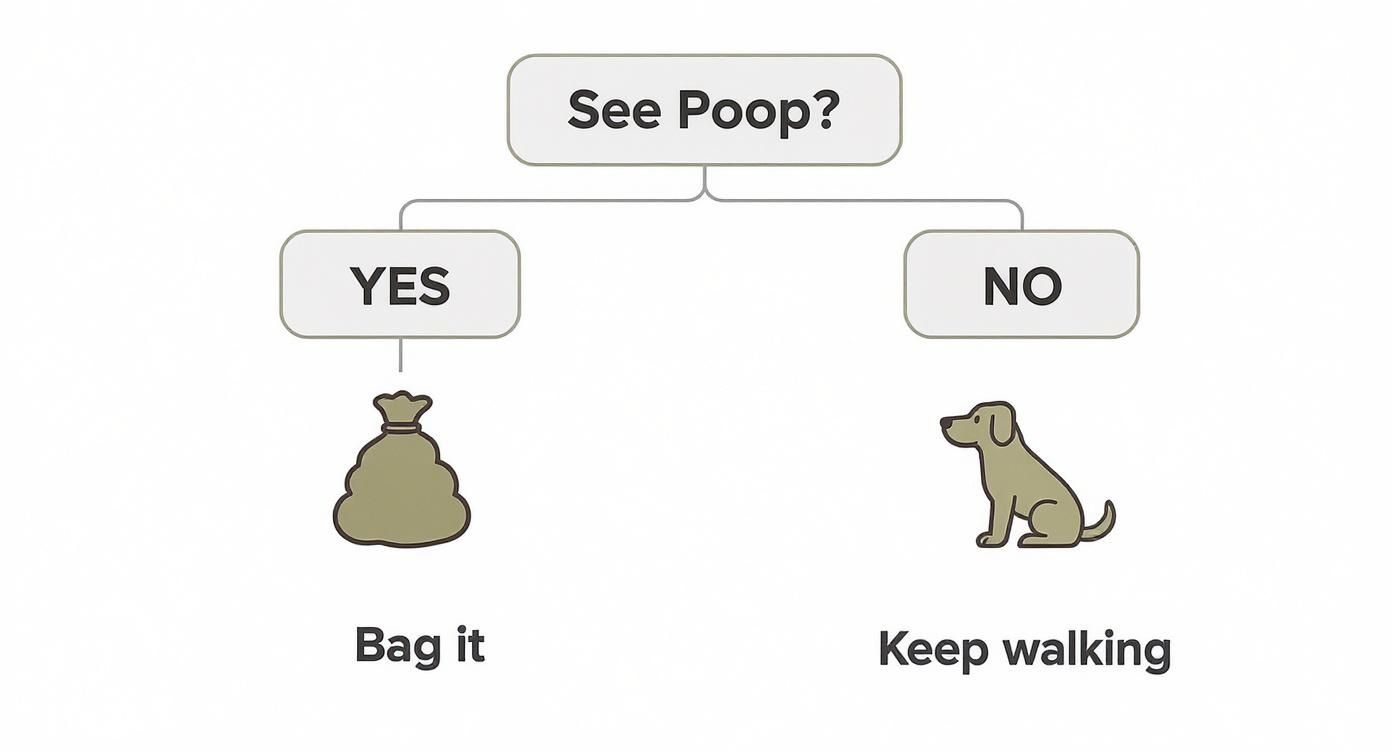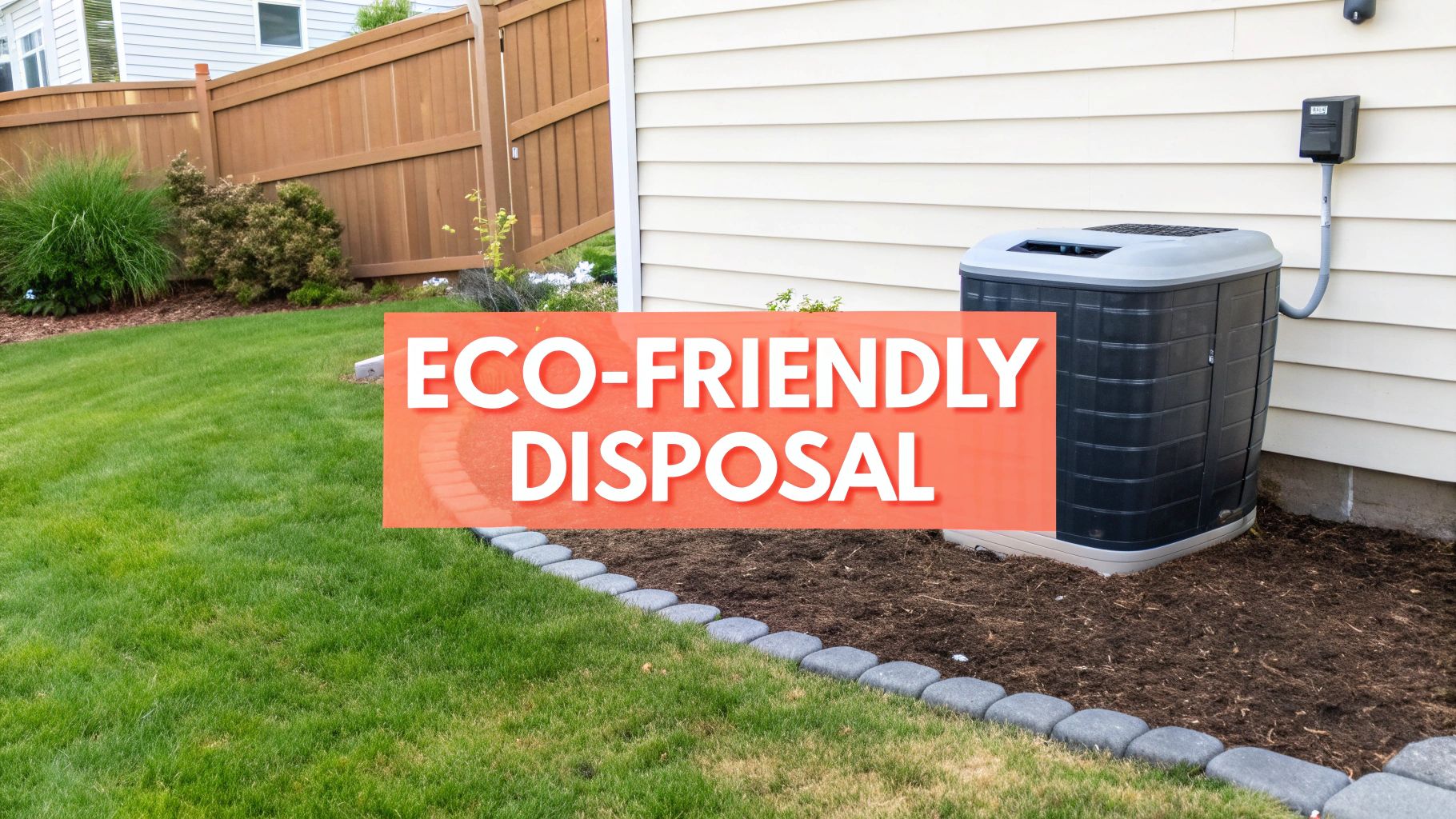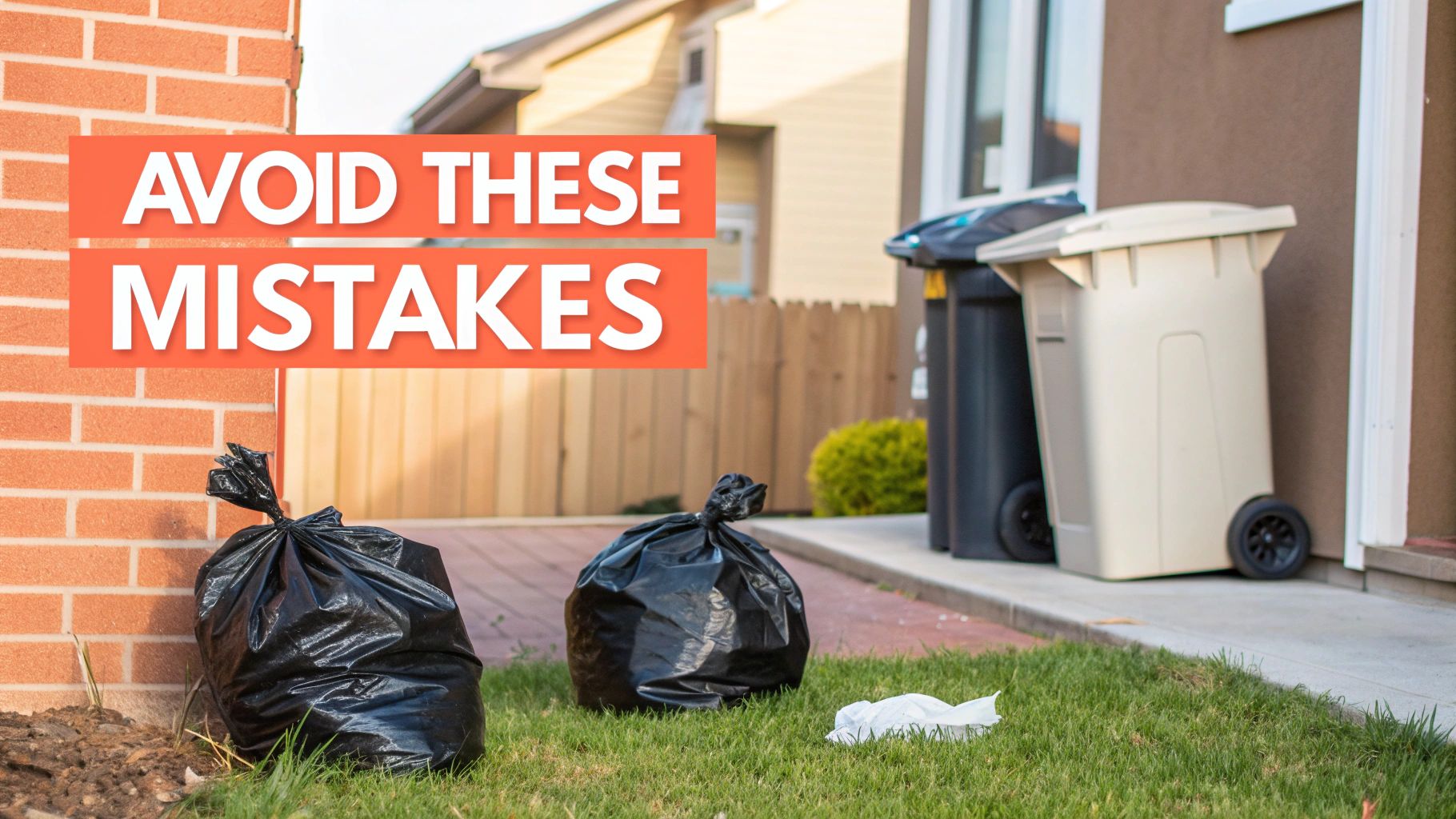Ah, the moment every dog owner knows well. You're on a perfect walk, the sun is shining, and suddenly your dog finds the spot. While we wouldn't trade our furry companions for the world, dealing with what they leave behind is a non-negotiable part of being a good owner and a good neighbor.
Properly handling dog waste isn't just about avoiding a fine or a dirty look—it’s a fundamental part of public health, environmental safety, and just plain good manners. This guide will walk you through the best methods for disposing dog waste, making the chore cleaner, safer, and easier.
It’s More Than Just an Eyesore
Let's be honest, picking up poop is a daily chore nobody enjoys. But ignoring it has consequences that reach far beyond a messy shoe. It's a choice that affects your entire community and the local environment.
Quick Fact: In the United States alone, our beloved dogs generate an estimated 21.2 billion pounds of waste every single year.
That’s a massive amount to manage. While studies show that about 60% of owners are great about cleaning up, the other 40% who sometimes leave it behind are contributing to a huge, stinking problem. If you're curious about the numbers, you can explore more pet waste statistics to see the full picture.
The Real Impact of "Leave It and Forget It"
Leaving dog poop on the ground isn't just unsightly; it introduces some serious risks. Unlike waste from wildlife, dog poop brings foreign bacteria and parasites into the ecosystem that don't belong there.
- Water Contamination: When it rains, all those germs from dog waste get washed straight into storm drains. From there, they pollute our rivers, lakes, and even the ocean. Serious
- Health Hazards: Dog feces can carry nasty pathogens like E. coli and Salmonella. It's also a breeding ground for parasites like roundworms, which can survive in the soil for a long time and pose a risk to other pets and even people.
- Lawn Damage: Forget the myth that it’s a natural fertilizer. The high nitrogen content in dog waste will "burn" grass, leaving those ugly yellow, dead patches on your lawn and in local parks.
The bottom line is simple: leaving dog waste behind contaminates public spaces and waterways. A quick, responsible pickup is one of the easiest ways you can be a good neighbor and protect your community's health.
Choosing Your Dog Waste Disposal Method
So, you’ve scooped the poop. Now for the million-dollar question: what do you do with it? While just tossing it in the nearest trash can is what most people do, it’s far from your only option for getting rid of dog waste. The right choice really comes down to your lifestyle, what’s allowed in your area, and what you’re comfortable with.
This decision tree offers a quick look at that very first step in the process.

While the infographic nails that initial action, picking the final resting place for that little baggie involves a bit more thought.
The Classic Bag-and-Toss
For most of us, especially city dwellers, this is the default setting. It's simple, convenient, and gets the job done from a public health standpoint. The catch? The type of bag you use really matters. A standard plastic bag will sit in a landfill for hundreds of years.
That’s why so many responsible owners are switching to biodegradable or compostable bags, which are designed to break down much faster when they end up in the right conditions.
This is also where a great pooper scooper makes a world of difference. A tool like Potomo’s pooper scooper is built to make the whole process completely hands-free. Thanks to its smart clip-on design and built-in bag dispenser, you can scoop, tie off the bag, and drop it in the bin without ever getting your hands near the mess. It turns a gross chore into a quick, clean, and hygienic task.
Greener Ways to Go
If you have a yard and want to find a more eco-conscious solution, you’ve got a few more options. They take a bit more effort up front, but can seriously shrink your dog’s environmental paw print.
- In-Ground Pet Waste Digesters: Think of these as a mini septic system just for your dog's business. You bury a small tank in your yard, add special enzymes and water, and the waste breaks down safely and naturally into the soil.
- Dedicated Pet Waste Composting: This is a big one. You should never add dog waste to your regular garden compost pile, especially if you're growing fruits or vegetables. Dog poop is full of pathogens that a standard compost bin just can't kill. Specialized pet waste systems use high heat to safely break everything down, turning it into a usable soil additive for your flower beds and ornamental plants.
- Professional Collection Services: In many areas, you can now hire companies that will come to your home and collect pet waste for a fee. They take it to a facility where it's properly handled, taking the job completely off your to-do list.
- A Quick Word on Flushing: It might seem like the easiest fix, but please don't flush dog poop. Most city water treatment systems aren't built to handle the unique bacteria and parasites found in dog waste. On top of that, even so-called "flushable" bags are notorious for causing major plumbing disasters. It’s a method best avoided.
Comparing Dog Waste Disposal Options
Feeling a little overwhelmed by the choices? Here’s a quick look at common disposal methods to help you decide which is best for you, based on convenience, cost, and environmental considerations.
| Disposal Method | Convenience Level | Environmental Impact | Best For |
|---|---|---|---|
| Traditional Trash | High | High (unless using compostable bags) | Urban dwellers, apartment living, and public spaces |
| In-Ground Digester | Medium | Low | Homeowners with yard space looking for a set-it-and-forget-it option |
| Pet Waste Composter | Low | Very Low (creates usable compost) | Eco-conscious homeowners with a yard and a bit of extra time |
| Collection Service | Very High | Varies by company | Busy families who want the most convenient, hands-off solution |
Ultimately, the best method is the one you’ll actually stick with. Being a responsible dog owner means seeing the job through to the end, and choosing the right disposal option makes that so much easier.
Making Cleanup a Hands-Free Experience
We've all been there: juggling a leash, a phone, and a flimsy plastic bag, trying to perform the world's most awkward cleanup maneuver. Thankfully, those days are fading fast. Modern tools have completely changed how we handle disposing of dog waste, making the whole process cleaner, faster, and way less gross.
The market backs this up. The demand for tools like dog poop bag dispensers hit USD 150 million in 2025 and is expected to climb to nearly USD 250 million by 2033. This isn't just a trend; it's a reflection of more people living with pets in urban areas and a growing desire for hygienic, no-fuss solutions. You can see the full breakdown in this market report.
This is where a purpose-built tool like Potomo’s pooper scooper really proves its worth. It’s designed for the reality of daily walks, solving the little annoyances that make cleanup a chore.
Why a Modern Scooper Changes the Game
A good pooper scooper isn't just about picking up poop. It’s about creating a completely hands-free experience from the moment you leave your house until the bag is in the bin. Think about cleaning up on a wet, muddy day without getting anything on your hands. That’s the goal.
-
Always Be Prepared: The best scoopers, like ours, have a built-in bag dispenser. It eliminates that sinking feeling you get when you're halfway down the block and realize you forgot to grab a bag.
-
Hygienic and Clean: This is the big one. It creates a physical barrier between your hands and the mess. This is key to preventing the spread of germs and just makes an unpleasant task far more bearable.
-
Lightweight and Portable: Modern designs are light and often clip right onto your leash or belt loop, so they're never a burden. They're easy to carry, whether you're heading around the block or out on a long hike.
The point of a great scooper isn't just to pick up waste—it's to make the entire process so quick and clean that it becomes an automatic part of your routine. This consistency benefits everyone in the community.
For more ideas on building a seamless cleanup system, check out our full guide on establishing a doggie waste disposal routine. When you have the right tools, you can turn a daily chore into a simple, responsible act that keeps your hands clean and your neighbors happy.
Understanding Eco-Friendly Disposal

Most dog owners want to do right by the planet, but stepping into the world of "green" disposing dog waste can feel like navigating a maze of confusing marketing terms. Let's cut through the jargon and get to the real story behind eco-friendly cleanup.
There's no doubt that biodegradable and compostable bags are a massive trend, with options made from materials like PBAT and PLA now selling over 19 million units a year. The appeal is obvious—some can decompose in as little as three months, which makes them a go-to for many of us. You can see just how fast this market is growing by checking out these stats on sustainable pet waste bags.
But here’s the catch: their effectiveness hangs entirely on what you do with them after the poop is scooped.
Biodegradable vs. Compostable: What’s the Difference?
It’s easy to use these terms interchangeably, but they mean very different things. Getting this right is the key to making a choice that’s genuinely good for the environment.
-
Biodegradable: This is a broad term that simply means the material will break down into smaller pieces over time. The problem is, "over time" can mean years, and it often leaves behind microplastics. It’s not the clean breakdown you might be picturing.
-
Compostable: These bags are usually made from plant-based materials designed to break down into non-toxic organic matter. For this to actually happen, though, they need very specific conditions—namely, the high heat found in an industrial composting facility.
A compostable bag tossed into a regular landfill won't actually compost. It gets trapped in an oxygen-free environment, meaning it breaks down incredibly slowly, much like a standard plastic bag.
Finding a Truly Green Solution
So, how can you make sure your good intentions actually count?
The first step is to check if your local municipality runs a commercial composting facility that accepts pet waste. Not all of them do, so a quick call or a visit to their website is the best way to find out for sure.
For those with a yard, a dedicated at-home pet waste composter is another fantastic route. These systems are specifically designed to reach the high temperatures needed to safely kill pathogens in dog waste. The end result is a nutrient-rich additive you can use on non-edible plants.
To see how these methods can fit into a cleaner, more streamlined routine, you might be interested in our guide on creating a complete dog waste disposal system.
Common Mistakes Dog Owners Make With Pet Waste

Even the most well-intentioned dog owners can accidentally fall into bad habits with disposing dog waste. Getting it wrong isn't just about appearances—it can damage your lawn, harm the local environment, and even pose health risks to your family.
The most common slip-up? Leaving dog poop in the backyard, thinking of it as a natural "fertilizer." In reality, dog waste is far too high in nitrogen and will burn your grass, leaving behind ugly yellow patches. Worse yet, that pile becomes a breeding ground for nasty bacteria.
Where Waste Should Never End Up
It's just as important to know what not to do. Some disposal methods actually cause more harm than good.
For instance, tossing a bag of poop into a storm drain sends it directly into our local rivers and lakes. And flicking it off into the woods might seem harmless, but it introduces non-native bacteria that can sicken wildlife.
A few other key disposal methods to avoid at all costs:
-
Flushing It Down the Toilet: This seems like a clean solution, but most municipal water treatment plants aren't equipped to filter out the specific parasites found in dog waste.
-
Tossing It in the Green Bin: Never add pet waste to your compost or yard waste bin unless you have explicit permission from your city. It can contaminate the entire batch.
-
Leaving Bags on the Trail: Leaving a tied-up bag on the side of a trail for "later" is still littering. A hands-free tool like Potomo’s pooper scooper makes it simple to carry the bag until you reach a proper trash can.
By learning about the unseen dangers in dog poop, you can see why proper disposal is so critical. It’s a small, simple act that has a massive impact on keeping your community clean and safe for everyone.
Frequently Asked Questions About Disposing Dog Waste
We get it. When it comes to dog poop, there are a lot of "what if" and "is it okay to" questions floating around. Let's tackle some of the most common ones so you can handle cleanup like a pro.
Is it okay to leave dog poop in my own yard?
No, you should always pick up dog poop, even in your own yard. It's not a natural fertilizer; its high nitrogen content burns grass, creating yellow, dead patches. More importantly, it can contain harmful bacteria and parasites (like roundworms) that can live in your soil for years, posing a health risk to your family and other pets. Rain can also wash these contaminants into local waterways.
Can I flush dog poop down the toilet?
This is a tempting shortcut, but the short answer is no. Wastewater treatment plants are designed for human waste, not for the unique cocktail of bacteria and parasites found in dog poop. Even so-called 'flushable' bags are a plumber's nightmare, as they often cause serious clogs in your pipes and the city's sewer system. Your safest bet is always to bag it and toss it in the trash.
What's the real difference between biodegradable and compostable poop bags?
This is a big one, as the terms are often used interchangeably but mean very different things.
-
Biodegradable just means something will break down eventually. This could take years and often leaves tiny bits of plastic (microplastics) behind.
-
Compostable bags are made from plant-based materials designed to break down into organic matter, but they need the high heat of a commercial composting facility to do so properly.
Tossing a compostable bag in a landfill means it won't compost, so unless you have access to a pet-waste-friendly facility, its environmental benefit is limited.
Is it better to throw dog poop in the trash or compost it?
Composting in a dedicated pet waste system is the most eco-friendly option, as it turns waste into a usable resource for non-edible plants. However, this requires specific equipment and effort. For most people, bagging the waste (ideally in a compostable bag) and placing it in a designated trash can is the most practical and responsible method for protecting public health.

